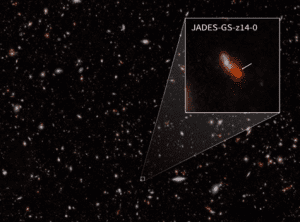TAG: GS 3: SCIENCE AND TECHNOLOGY
THE CONTEXT: NASA’s James Webb Space Telescope (JWST) has made a groundbreaking discovery by spotting the earliest-known galaxy, named JADES-GS-z14-0.
EXPLANATION:
- This discovery has significant implications for our understanding of the universe’s infancy and the formation of galaxies during the cosmic dawn.
- The discovery was made by an international team of astronomers as part of the JWST Advanced Deep Extragalactic Survey (JADES) program.
- The study, which has been published online ahead of formal peer review, used JWST’s ability to observe galaxies across vast cosmic distances, effectively looking back in time.
- Before this discovery, the earliest-known galaxy dated back to about 320 million years after the Big Bang, identified by the JADES team last year.
- The identification of JADES-GS-z14-0 pushes this record further back by 30 million years.
Significance of the Discovery
- Size Comparison:
- Astrophysicist Kevin Hainline noted that JADES-GS-z14-0 is significantly larger than other galaxies observed at similar distances.
- This raises questions about how such a large structure could form so quickly after the Big Bang.
- Brightness:
- The galaxy’s brightness is also noteworthy.
- Typically, galaxies grow brighter as they evolve and accumulate more stars.
- The fact that JADES-GS-z14-0 is already so bright suggests it has unique properties or formation processes.
- Second Oldest-Known Galaxy:
- Alongside JADES-GS-z14-0, the JADES team also discovered another ancient galaxy, JADES-GS-z14-1.
- This galaxy, from about 303 million years post-Big Bang, is smaller, with a mass equal to about 100 million solar masses and a size of roughly 1,000 light-years across.
- It forms about two new stars per year.
Hypotheses on Luminosity
- Researchers have proposed three main hypotheses to explain why early galaxies like JADES-GS-z14-0 are so luminous:
- Supermassive Black Holes: Initially, it was thought that supermassive black holes might be consuming material and emitting large amounts of light. However, the observed light is spread over a wider area than this theory would suggest, effectively ruling it out.
- Higher Star Population: Another hypothesis is that these galaxies might contain more stars than expected.
- Brighter Stars: Alternatively, the stars in these early galaxies might be intrinsically brighter than those found in more mature galaxies today.
- Further investigation is needed to determine which of the remaining hypotheses — higher star population or intrinsically brighter stars — holds true.
JADES-GS-z14-0
- Size and Distance:
- JADES-GS-z14-0 measures approximately 1,700 light-years across.
- Given that a light year is the distance light travels in a year, about 9.5 trillion kilometers, this galaxy is quite expansive for its age.
- Age and Formation:
- The galaxy existed around 290 million years after the Big Bang, placing it in the period known as the cosmic dawn, which spans the universe’s first few hundred million years.
- Mass and Star Formation:
- JADES-GS-z14-0 has a mass equivalent to 500 million solar masses and is forming new stars at a rapid rate of about 20 per year.
- This rate of star formation is remarkable considering the early universe’s conditions.

Black Hole:
- Black holes are points in space that are so dense they create deep gravity sinks. Beyond a certain region, not even light can escape the powerful tug of a black hole’s gravity.
- In other words, Black holes are regions in space where an enormous amount of mass is packed into a tiny volume.
Galaxy:
- Galaxies consist of stars, planets, and vast clouds of gas and dust, all bound together by gravity. The largest contain trillions of stars and can be more than a million light-years across.
- The smallest can contain a few thousand stars and span just a few hundred light-years. Most large galaxies have supermassive black holes at their centers, some with billions of times the Sun’s mass.
- Galaxies come in a variety of shapes, mostly spirals and ellipticals, as well as those with less orderly appearances, usually dubbed irregular.
- Most galaxies are between 10 billion and 13.6 billion years old. Some are almost as old as the universe itself, which formed around 13.8 billion years ago. Astronomers think the youngest known galaxy formed approximately 500 million years ago.

